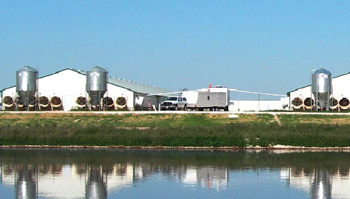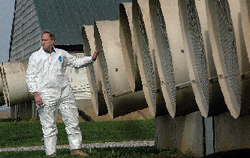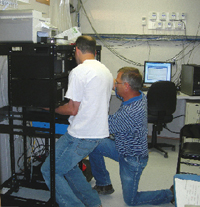
Features
Applications
Swine
Purdue begins national study of air quality at animal feeding operations
March 12, 2008 by Douglas Main & Kay Ledbetter
Research has officially begun in
the largest study ever conducted to measure levels of various gases and
airborne pollutants emitted from poultry, dairy and swine facilities
across the nation.

|
| A trailer from Purdue University used for housing air quality monitoring equipment is placed between two of the barns located at an Oklahoma Panhandle site. The equipment will be taking measurements for the next two years.
Photo By Dr. Ken Casey, Texas Agricultural Experiment Station.
|
Research has officially begun in the largest study ever conducted to measure levels of various gases and airborne pollutants emitted from poultry, dairy and swine facilities across the nation.
Led by Purdue University, the 2.5 year, $14.6 million study is measuring the levels of hydrogen sulfide, particulate matter and ammonia, among other chemicals, released from livestock facilities. Measurements have started in locations throughout the country and will be underway at all 20 study sites in eight states by mid-summer.
“This study will give us a wealth of much-needed scientific information about livestock-generated air pollution,” says Dr. Al Heber, the Purdue professor of agricultural and biological engineering leading the study. “There has never been a study this comprehensive or long-term.”
The National Air Emission Monitoring Study, conducted under the advisement of the U.S. Environmental Protection Agency (EPA), will record two continuous years of emission data at concentrated animal feeding operations (CAFO). These comprise barns and manure storage units, such as lagoons.

|
| Dr. Al Heber, a Purdue professor of agricultural and biological engineering, inspects a ventilation fan during a May training event at a swine-rearing facility in central Indiana. Dr. Heber leads the largest-ever nationwide study to measure dust and gas emissions at swine, dairy and poultry facilities.
Photo By Tom Campbell, Purdue Agricultural Communication.
|
Using advanced measurement tools and methods, this study will fill gaps in EPA’s database, Dr. Heber says, since little quantitative research has been done on these emissions.
Researchers will also measure emissions from open-air sources, such as dairy corrals and manure basins and lagoons. Specialized sensors, including lasers and reflectors, will measure levels of hydrogen sulfide and ammonia released.
“This data will help us to estimate the quantity of emissions given a farm’s activities and number of animals,” says Dr. Richard Grant, a professor of agronomy and a principal investigator in the study. He says the study would help develop an “emissions-estimating methodology.”
In addition to the large amount of data that will be gathered, Dr. Heber
says the study will establish infrastructure that should later allow researchers to test different abatement strategies to improve downwind air quality. “For example, if we put hogs on certain diets, we can significantly reduce ammonia emissions,” Dr. Heber says. “These experiments are needed to develop real solutions in the field.”
Other studies have shown that levels of emissions vary by temperature and time of day, factors that can be considered in developing better air emission controls, Dr. Heber says. Many of the producers whose farms are being monitored in the study have indicated receptiveness to follow-up studies on such mitigation strategies, he says.
Purdue will collaborate with 11 researchers from seven different universities in the study. These include Drs. Frank Mitloehner and Ruihong Zhang from the University of California-Davis; Curt Gooch from
Cornell University; Drs. Steve Hoff, Jacek Koziel and Jay Harmon from Iowa State University; Dr. Larry Jacobson from the University of Minnesota; Drs. Wayne Robarge and Lingjuan Wang from North Carolina State University; Dr. Pius Ndegwa from Washington State University-Pullman; and Dr. Ken Casey from Texas A&M University’s Agricultural Experiment Station.

|
| Texas Agricultural Experiment Station research assistants Al Caramanica (standing) and Gary Smith (kneeling) install monitoring equipment at a hog farm located in the Oklahoma Panhandle. The equipment will monitor ammonia, carbon dioxide, hydrogen sulfide and dust.
Photo By Dr. Ken Casey, Texas Agricultural Experiment Station.
|
A pork operation located in the Oklahoma Panhandle has already been chosen as a research site. Dr. Casey and his crew from Texas A&M will monitor ammonia, carbon dioxide, hydrogen sulfide and particulate matter, continuously, from the buildings while another researcher will periodically monitor emissions from the lagoon. Purdue has already sent a trailer fully equipped with instrumentation to the site, Dr. Casey explains. It will take about two months to install and calibrate the system.
Dust at the pork operation will be measured by a piece of equipment called tapered element oscillating microbalance, the researcher says, which gives a continuous measurement of the air being exhausted from the fans on the building.
Likewise, Dr. Casey says, samples from representative fans in each building will be drawn continuously by monitors
to the instrument trailer and be analyzed for ammonia, carbon dioxide and hydrogen sulfide.
“These measurements will give us concentration,” he says. “To get emission rates, we’ll also have to know how much air is being exhausted from the building, which is done by continuously monitoring the status of each fan and the resistance against which it operates.”
The instruments’ functions and calibration will be checked weekly by a research associate from Amarillo, says Dr. Casey. The system will be monitored daily online, and data will be e-mailed nightly to Dr. Heber at Purdue and Dr. Casey in Amarillo.
This study is being funded by the Agricultural Air Research Council, a
non-profit organization funded by livestock industry groups. The project is being overseen by the EPA Office of Air Quality Planning and Standards.
Douglas Main is a science writer with Purdue University’s Agricultural Communications department. Kay Ledbetter is a writer with Texas
A&M University’s News and Public Affairs Department.